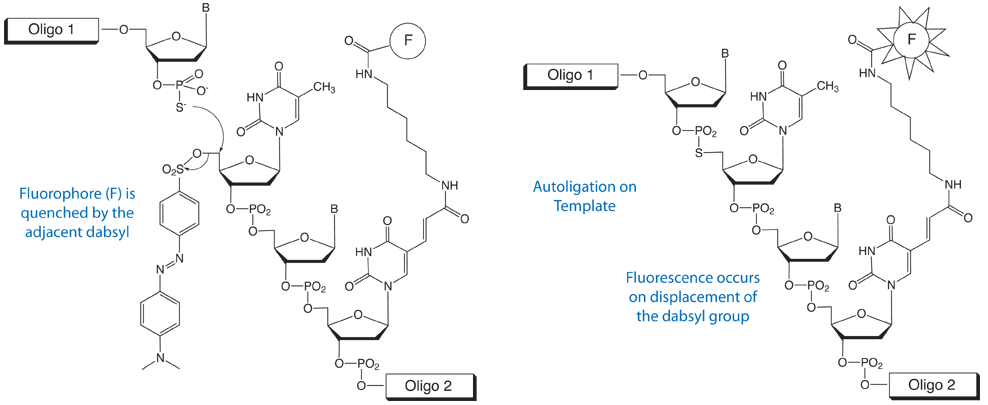Glen Report 19.16: Quenched Autoligation (QUAL) Probes
The search for improvements in oligonucleotide probe-based assays has continued over the last few years.1,2 One diagnostic probe strategy that has caught our attention is the one developed by the Kool lab at Stanford University, which they have named quenched autoligation (QUAL) probes.3 QUAL probes consist of two oligonucleotides, the first containing a nucleophilic group at the 3’-terminus, while the second has an electrophilic group at the 5’-terminus. When the probe pair finds the target, the oligos line up with the 3’-terminus of the first directly adjacent to the 5’-terminus of the second. A Kool autoligation reaction then takes place to combine the two oligos into a single probe. As usual, the 3’ nucleophilic group is the 3-thiophosphate easily prepared using 3’-phosphate CPG with a sulfurizing step in the first cycle. In this case, the electrophilic group is a 5’-dabsyl group, which is an excellent leaving group as well as a fine quencher of fluorescence. The second oligo, therefore, contains a fluorophore which is quenched by the dabsyl group. A popular choice for fluorophore is fluorescein-dT but it is easy to imagine that a variety of fluorophores could be attached to any of the commercially available amino-modified nucleoside phosphoramidites. The process is illustrated in Figure 1.

The efficacy of this procedure has recently been illustrated in intact cells. Using fluorescence microscopy or flow cytometry, QUAL probes were able to distinguish single nucleotide differences in the 16S rRNA sequences of three closely related bacteria. Even a single mismatch was revealed by a significant decrease in fluorescence signal.4 By combining QUAL with FRET, Abe and Kool were able to substantially reduce the background signal arising from the release of the dabsyl group. In this way, they were able to detect and quantify three different messenger RNAs, as well as 28S ribosomal RNA, by flow cytometry.5
Glen Research is happy to offer 5’-Dabsyl-dT CE Phosphoramidite (1) to allow the simple synthesis of 5’-O-dabsyl QUAL probes.

References
- E.A. Lukhtanov, et al., Nucleic Acids Res, 2007, doi:10.1093/nar/gkl1136.
- A.P. Silverman and E.T. Kool, Trends Biotechnol, 2005, 23, 225-30.
- S. Sando and E.T. Kool, J Amer Chem Soc, 2002, 124, 2096-2097.
- A.P. Silverman and E.T. Kool, Nucleic Acid Res, 2005, 33, 4978-4986.
- H. Abe and E.T. Kool, Proc. Natl. Acad. Sci. U. S. A., 2006, 103, 263.
Product Information
- Glen Report 19.11: Modified RNA Phosphoramidites Useful in siRNA Research and Biologically Significant 1-Methyl-adenosine
- Glen Report 19.12: 1-Methyl-Adenine in Nucleic Acids
- Glen Report 19.13: Technical Brief - Precautions During Packaging of Phosphoramidites and Transfer into Alternative Vials
- Glen Report 19.14: Microarrays, Nanotechnology and Beyond
- Glen Report 19.15: 5’-Hexynyl Phosphoramidite – Conjugation with a Click
- Glen Report 19.16: Quenched Autoligation (QUAL) Probes
- Glen Report 19.17: Selenium Derivatization of Nucleic Acids for X-ray Crystal Structure Determination
- Glen Report 19.18: Large Scale Synthesis Update
- Glen Report 19.19: NHS-Carboxy-dT – Expanding the NHS Ester Phosphoramidite Repertoire

